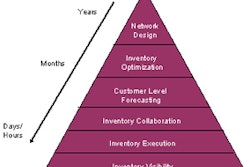Detroit — January 4, 2007 — Facing overcapacity issues and a consequent murky profit outlook, automotive executives worldwide expect an industry shakeout over the next five years, with some companies choosing bankruptcy and others seeking to merge or form alliances, according to an annual global automotive survey by KPMG, the U.S. audit, tax and advisory firm.
The KPMG survey, based on interviews with 150 senior executives at vehicle manufacturers and suppliers worldwide, found they overwhelming expect alliances, mergers and acquisitions among vehicle manufacturers, tier-one and tier-two and –three, suppliers to increase globally over the next five years as the automotive supply chain continues to evolve.
When viewed by region, 81 percent of Asian executives expect global consolidations and alliances to increase over the next five years, followed by 58 percent of North American executives and 56 percent of Eastern European executives. Only in Western Europe were executives less bullish, with 32 percent of respondents expecting an increase in global alliances, mergers and acquisitions.
Consolidation in Industry
"The majority of the auto industry views this as a time of consolidation, not expansion, as many expect global overcapacity to exceed 10 percent," said Daron Gifford, national automotive industry leader with KPMG. "The reasons for this consolidation are clearly structural and material-cost reduction, as well as revenue growth through new business opportunities."
For the fourth consecutive year, slightly more than half of the executives, 57 percent, agree that alliances will be more important than mergers and acquisitions in the auto industry over the next five years.
Consolidation across the automotive supply chain is also on the minds of executives, with 59 percent expecting an increase in consolidations and alliances among vehicle manufacturers and Tier 1 suppliers, while 61 percent of executives anticipating an increase for Tier 2-3 suppliers, and 41 percent saying dealers. Forty-nine percent of executives say they expect consolidation activity will be affected by the potential for product synergies, while 44 percent say access to new markets and customers are the key factors.
Bankruptcy as a Strategic Option
Strikingly, 87 percent of executives said they think the rate of bankruptcy in the industry over the next few years will increase or remain the same, and slightly more than half (56 percent) believe the rate will increase as companies choose to file for such protections as a strategic option. Only 10 percent expect a decrease in bankruptcy activity.
"Not surprisingly, bankruptcy is on the minds of industry executives," said Gary Silberg, lead automotive partner in KMPG LLP's Transaction Services practice. "With shrinking market share, ongoing cost cutting and other pressures, beleaguered companies are tempted to reorganize by way of bankruptcy, which provides them protection from creditors while they sort out their affairs as they seek to strategically restructure and gain breathing room to meet their obligations."
In the KPMG survey, 47 percent of auto execs see noncompetitive cost structure as the driving force of bankruptcy. But the story is different when broken down by region:
Optimism for Profits Uncertain
In terms of profitability, 42 percent of executives are predicting that industry profits will be flat or generally rise over the next five years, showing marginally high optimism when compared with last year's 39 percent. Asian executives, at 43 percent, and their European counterparts, 45 percent, are more positive about profits increasing over the next five years than North American executives, 38 percent, who feel the industry will continue to be volatile and unpredictable.
Meanwhile, 54 percent of vehicle manufacturers and 41 percent of tier-two and –three suppliers believe profitability will remain flat or rise, compared to only 37 percent of tier-one suppliers.
"Last year, expectations for profitability were low industry-wide due to wide uncertainties resulting from natural disasters and increased energy costs," said Gifford. "Now that the business environment has settled down, vehicle manufacturers and suppliers are focused on their operations and adjusting their strategies to meet the changing needs of consumers."
Additional key findings include:
The KPMG survey, based on interviews with 150 senior executives at vehicle manufacturers and suppliers worldwide, found they overwhelming expect alliances, mergers and acquisitions among vehicle manufacturers, tier-one and tier-two and –three, suppliers to increase globally over the next five years as the automotive supply chain continues to evolve.
When viewed by region, 81 percent of Asian executives expect global consolidations and alliances to increase over the next five years, followed by 58 percent of North American executives and 56 percent of Eastern European executives. Only in Western Europe were executives less bullish, with 32 percent of respondents expecting an increase in global alliances, mergers and acquisitions.
Consolidation in Industry
"The majority of the auto industry views this as a time of consolidation, not expansion, as many expect global overcapacity to exceed 10 percent," said Daron Gifford, national automotive industry leader with KPMG. "The reasons for this consolidation are clearly structural and material-cost reduction, as well as revenue growth through new business opportunities."
For the fourth consecutive year, slightly more than half of the executives, 57 percent, agree that alliances will be more important than mergers and acquisitions in the auto industry over the next five years.
Consolidation across the automotive supply chain is also on the minds of executives, with 59 percent expecting an increase in consolidations and alliances among vehicle manufacturers and Tier 1 suppliers, while 61 percent of executives anticipating an increase for Tier 2-3 suppliers, and 41 percent saying dealers. Forty-nine percent of executives say they expect consolidation activity will be affected by the potential for product synergies, while 44 percent say access to new markets and customers are the key factors.
Bankruptcy as a Strategic Option
Strikingly, 87 percent of executives said they think the rate of bankruptcy in the industry over the next few years will increase or remain the same, and slightly more than half (56 percent) believe the rate will increase as companies choose to file for such protections as a strategic option. Only 10 percent expect a decrease in bankruptcy activity.
"Not surprisingly, bankruptcy is on the minds of industry executives," said Gary Silberg, lead automotive partner in KMPG LLP's Transaction Services practice. "With shrinking market share, ongoing cost cutting and other pressures, beleaguered companies are tempted to reorganize by way of bankruptcy, which provides them protection from creditors while they sort out their affairs as they seek to strategically restructure and gain breathing room to meet their obligations."
In the KPMG survey, 47 percent of auto execs see noncompetitive cost structure as the driving force of bankruptcy. But the story is different when broken down by region:
- 70 percent of European executives cite noncompetitive cost structure as the greatest cause of potential bankruptcies in the industry.
- 28 percent of North American executives say health care and benefits costs are the key drivers of possible bankruptcy.
- 17 percent of Asian executives name excess debt as the main reason for potential bankruptcy.
Optimism for Profits Uncertain
In terms of profitability, 42 percent of executives are predicting that industry profits will be flat or generally rise over the next five years, showing marginally high optimism when compared with last year's 39 percent. Asian executives, at 43 percent, and their European counterparts, 45 percent, are more positive about profits increasing over the next five years than North American executives, 38 percent, who feel the industry will continue to be volatile and unpredictable.
Meanwhile, 54 percent of vehicle manufacturers and 41 percent of tier-two and –three suppliers believe profitability will remain flat or rise, compared to only 37 percent of tier-one suppliers.
"Last year, expectations for profitability were low industry-wide due to wide uncertainties resulting from natural disasters and increased energy costs," said Gifford. "Now that the business environment has settled down, vehicle manufacturers and suppliers are focused on their operations and adjusting their strategies to meet the changing needs of consumers."
Additional key findings include:
- 96 percent of executives expect manufacturing to grow in Asia.
- 60 percent of executives expect increases in manufacturing in South America and Eastern Europe.
- 62 percent of executives do not believe the number of vehicle manufacturers will decrease in China.
- 75 percent of all executives agree that automakers and suppliers will continue to make significant investments in China over the next five years.
- 38 percent of executives say China and 29 percent say Japan are best situated to take advantage of the growing Chinese automotive industry.
- 73 percent of executives cite India as the next region, aside from China, to undergo the greatest growth.









